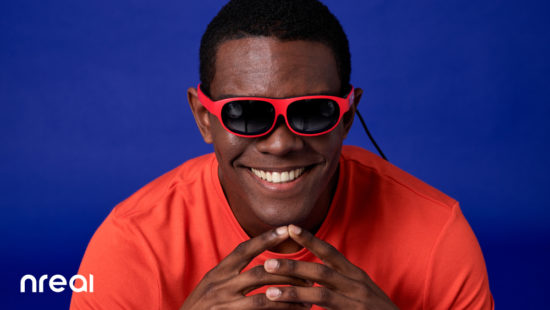Bright, good FOV, reasonable price
Remember JP’s rules for AR:
- Don’t be ugly or obnoxious
- Don’t be expensive or heavy
- Don’t be proprietary
nreal comes very close to meeting all three requirements. The glasses are lightweight, they are not intrinsically ugly or obnoxious, but are obnoxiously colorful probably for market attention—hopefully, that can be toned-down for people over 25. They are not too expensive at $500 but should be less expensive, and they are not tied to any proprietary system. That’s 2.5 out of 3 or 83%.
At AWE 2019, nreal had some demo systems on display.

nreal projects a 1080p image on the glasses, with a 52º FOV. The visuals were stunningly bright and colorful. The entire lens area is illuminated, which makes the glasses suitable not just for textual and map overlays but for game playing and video viewing.
nreal’s device requires a cable into a separate processor pack that’s designed to go into your pocket. We think this is a sensible approach, and so does Qualcomm. Because the processor pack uses USB-C, one will be able to use their smartphone to power the glasses and take advantage of the sensor array and network connections. However, the company says as of now it’s only working with Samsung on that feature.
The nreal glasses employ a Qualcomm Snapdragon 855 and come equipped with 360-degree spatial sound through two speakers. There are built-in microphones to enable future voice control and smart assistants. There are two cameras in the front for SLAM.
The glasses are very lightweight, only 85 g and are expected to be available sometime in the third quarter of the year.
The company is also offering a $1,199 developers kit that includes the glasses, a controller, and a dedicated computing pack that can substitute for a phone.
nreal is one of the first headset makers to participate in Qualcomm’s XR certification program, which will take advantage of 5G networks and make streaming of high-quality of games, software, or video available to the glasses.
What do we think?
Because Magic Leap and HoloLens are so high-profile, comparisons are being made to them. That’s like comparing a dump truck to a sports car because they both have wheels and can move someone from point a to point b. nreal and HoloLens and Magic Leap have nothing in common.
A better comparison would be the consumer devices listed in my recent article. In it, I show examples of other consumer AR glasses like Focals, Shima, and AVIwear, or even SME Viewpoint system.
I am very excited about the nreal glasses and hope to get a unit to evaluate.
Initially, you will be able to get them in white or orange.







